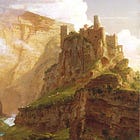Repairing the Damage
Diary of a Stosstrupp Leader (Part 7)
This post continues the translation of the diary of a German soldier who fought in the First World War. Readers can find links to other posts in this series in the following guide.
17 October 1916
We rested until noon. In the afternoon, my squad and I went to the battalion (supply dump) to obtain ammunition.
From eight pm until one the next morning, wagons from the Thick Oak were able to move forward to the battalion (supply dump) to deliver stakes for wire entanglements to the sector of the First Platoon.
18 October 1916
In the afternoon, we moved through the company communication trench to carry stakes and barbed wire from the Thick Oak From seven pm until midnight, in pitch black darkness, we carried barbed wire from the Thick Oak and Spanish riders from the battalion (supply dump), sometimes under cover, to the wire entanglements of the First Platoon, that had been partially destroyed during the attack, in order to improve them and make them more secure.
If the continuous rifle fire was any indication, the Russians seemed to be highly unsettled. While this was going on, a shell would occasionally whistle over us.
While we worked on the barbed wire entanglements, we had no trench to protect us. It was a good thing that it was so dark, lest the Russians see us and subject us to well-aimed fire.
19 October 1916
In the afternoon, we carried wire and stakes from the Thick Oak. We got mail from home.
20 October 1916
From midnight to three am, we carried material for our fighting trenches from the Thick Oak. I lost my way, and spent two uncomfortable hours in my old trench. (During the day) we carried wire and clamps. In the evening, we piled earth upon our shelters and built a chimney in the wall.
21 October 1916
I went to the neighboring sector to look for (Officer Candidate Sergeant) Hartmann. In the afternoon, in a driving rain, we carried sheathing timber, planks, and barbed wire from the Thick Oak. We also escorted a medic, as one of my men was severely wounded by a shot in the thigh.
In the evening, my seven men and I shoveled out the company communication trench.
22 October 1916 (Sunday)
We continued to shovel until five am. At six twenty am, we attended pay call.
23 October 1916
We cleaned our rifles, and then, until noon, cleaned up our trenches. Nothing else happened to our squad.
Our rations were meagre. For every three men there was a container of wheat or barley soup. Each man got half of a loaf of bread and spoonful of marmalade. Nonetheless, my men proved willing, energetic, and disciplined. I usually worked with them.
As it was warm, we took off our jackets. An officer who was passing by asked to see the sergeant in charge, so I told him that I was the squad leader.
From two to five in the afternoon, we carried twenty-rolls of barbed wire from the Thick Oak through the long approach trenches and cut down trees. From six until eleven thirty in the evening we carried supports for our trenches.
25 October 1916
We obtained replacements for supports that had been stolen.
Heavy artillery and trench mortar fire caused us to run into the communications trench.
Private Jacky got shot in the foot.
In the afternoon, we carried wood for panelling.
Reserve Lieutenant Peters was transferred to the Seventh Company. My new platoon leader is First Sergeant (Feldwebel) Affler.
26 October 1916
Private (Musketier) Vogt joined my squad. We carried framing timbers from the Thick Oak.
27 October 1916
In the morning we carried barbed wire and stakes for obstacles. In the afternoon we shoveled mud out of trenches.
28 October 1916
We cleaned out communication trenches. Had we not done this, they would have remained impassable, and, when the Russians attacked again, no reserves would be able to move through them in order to occupy the fighting trenches.
During the night, during a heavy rain, we carried hundred-pound shells for medium trench mortars from the ammunition depot.
to be continued …
Sources
The text comes from Alwin Lydding Meine Kriegstagbuch (My War Diary), unpublished manuscript, Bundesarchiv (German Federal Archive) N 382/1
The photo comes from the Großer Bilderatlas des Weltkrieg, Dritter Band (Munich: Bruckmann, 1919) page 55
For Further Reading






I am sure that at some points these soldaten must have wondered if they were not actually donkeys or beavers.